| dc.description.abstract | When oil and gas wells reach the end of their production life, they need to be permanently
plugged and abandoned. The requirements for a permanent barrier state that it must cover
the entire cross-section of the wellbore, including all annuli. This thesis evaluates a new
method of establishing a cross-sectional barrier in areas with poor, non-sealing annular
cement.
The traditional method is to mill away the section with poor cement and set an open hole
cement plug, but due to the ECD effect of milling fluids, this is not always desirable. In some
formations on the Gullfaks field, the operational pressure window is too small for section
milling. An alternative solution was therefore tried out on a well that needed plugging.
This method, referred to as punch and squeeze, consisted of perforating the section of
poorly cemented casing and squeezing cement into the annulus. In this thesis, the
equipment and techniques used are presented and evaluated, along with general theory
relevant to plugging and abandonment.
On Gullfaks, two punch and squeeze techniques were used. In the first, cement was pumped
through a packer plug and squeezed into the perforations. The second technique involved
setting a balanced cement plug over the perforations, and squeezing this plug into the
perforations.
The main conclusions are that the technique using a packer plug is safer with regards to well
control, involves less waiting on cement and gives a better annular seal than the balanced
plug alternative. Also, a cement evaluation log should be run before the squeeze jobs are
performed, and the log results should be used when determining where to perforate. All
things considered, it was found that the punch and squeeze method can succeed in creating
a length of cross-sectional cement, but still involves some uncertainty and the technique can
be further optimized. | en_US |
